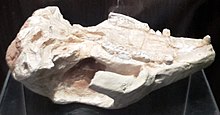Chulsanbaatar
| Chulsanbaatar | |
|---|---|

| |
| Skull replica shown from below, Museum of Evolution of Polish Academy of Sciences, Warsaw | |
| Scientific classification | |
| Domain: | Eukaryota |
| Kingdom: | Animalia |
| Phylum: | Chordata |
| Class: | Mammalia |
| Order: | †Multituberculata |
| Superfamily: | †Djadochtatherioidea |
| Genus: | †Chulsanbaatar |
| Species: | †C. vulgaris
|
| Binomial name | |
| †Chulsanbaatar vulgaris Zofia Kielan-Jaworowska, 1974
| |
Chulsanbaatar is an extinct
Fossil remains of the species Chulsanbaatar vulgaris have been found in multiple localities in the Gobi Desert, including the Red Beds of Hermiin Tsav (also known as Khermeen Tsav, part of the Barun Goyot Formation) in Mongolia. They range in the fossil record from 84 to 71 million years ago, from the late Santonian, through the Campanian and early Maastrichtian ages. [2]
This small multituberculate had a 2 centimetres (0.79 in) long skull. Remarkably, it has been possible to study the ear bones, which shows how well some of the fossils are preserved. [ which is similar to a small modern mouse. According to detailed reconstructions by Kielan-Jaworowska and Gambaryan, Chulsanbaatar was likely nocturnal due its large eyes, and had live births but relatively undeveloped young due to its pelvic structure. It likely was behaviorially similar to that of the modern
The type specimen of Chulsanbaatar is now a resident of the Polish Academy of Science in
Notes
References
- Dykes, Trevor. "Mesozoic Mammals; Djadochtatherioidea, an internet directory". Archived from the original on 21 April 2003.
- Kielan-Jaworowska, Zofia (1974). "Multituberculate succession in the Late Cretaceous of the Gobi Desert (Mongolia)". Palaeontologica Polonica. 30: 23–44.
- Turnbull, W.D. (1995). "Book Review, Postcranial anatomy and habits of Asian multituberculate mammals: : Z. Kielan-Jaworowska and P.P. Gambaryan, 1994. Scandinavian University Press, Oslo, Norway. Paperback, 92 pp. ISBN 82-00-37650-8". Earth-Science Reviews. 39 (3–4): 267–268. .
- Wilson, Gregory P.; Evans, Alistair R.; Corfe, Ian J.; Smits, Peter D.; Fortelius, Mikael; Jernvall, Jukka (2012). "Adaptive radiation of multituberculate mammals before the extinction of dinosaurs". Nature. 483: 457–460. .


